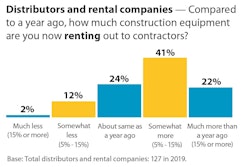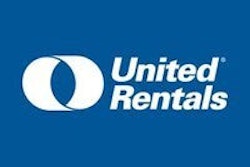Equipment rental market observers have for some time been bracing for a correction in the current growth trajectory, but so far, it has yet to come. In fact, the latest predictions are for still more industry expansion, albeit at a slightly slower pace than in recent years.
Projections for growth in 2019
The latest five-year forecast from the American Rental Association (ARA) calls for equipment and event rental revenues in North America to surpass $61.5 billion in 2019, including $55.8 billion in the United States and $5.7 billion in Canada, up 5.3 percent compared to 2018.
Similar steady growth is expected in each of the successive years of the forecast to reach nearly $70.9 billion in revenue by 2022.
The current figures, which are updated quarterly, project slightly less growth than what was forecast in October, reflecting different factors that have slightly slowed the projected growth of the U.S. economy.
“This remains a strong forecast for a growing industry that continues to expand faster than the overall economy,” says John McClelland, Ph.D., ARA vice president for government affairs and chief economist.
In the U.S., equipment and event rental revenue is expected to grow another 4.8 percent in 2020, 5 percent in 2021 and 4.8 percent in 2022 to reach $64.4 billion.
What’s driving it?
“Last year, a lot of construction industry companies had record sales and profits,” says Peter Gregory, national manager for Wells Fargo Equipment Finance Construction Manufacturer and Dealer Services Group. “As I’ve talked to our rental clients over the past few months, they all are expecting another great year. There appears to be a really good pipeline of future construction work which aligns with the high optimism we are seeing throughout the industry.”
He continues, “Last year, due to long equipment order backlogs from many manufacturers, we saw that a lot of dealers having to sell equipment out of their rental fleets in order to not lose sales opportunities to their clients. They will continue to replace that rental equipment this year as new equipment arrives. Most are very optimistic that the demand for sales and rentals will continue to be strong in 2019.”
Rental penetration — the percentage of total construction equipment in use in the United States that is owned by equipment rental companies — increased to 53.5 percent in 2018, up from 53.0 percent in 2017, according to the ARA.
“Rental operators are anticipating another good year but have remained disciplined around adding inventory,” says McClelland. “The effect of better fleet management is that minor fluctuations in the business cycle will not be overly disruptive to the rental industry.”
Still, there is something of a slow-down. The question is whether it will have any significant effect.
Scott Hazelton, managing director, IHS Markit, the forecasting firm that compiles data and analysis for the ARA Rentalytics subscription service as part of a partnership with ARA, says real gross domestic product (GDP) growth in the U.S. is expected to be 2.5 percent in 2019 compared to 2.9 percent in 2018, resulting in the mild softening of the near-term growth outlook.
“The slightly lower increases projected in the new forecast are the result of slightly lower economic expectations. IHS Markit has lowered its GDP outlook marginally for 2019 and 2020, but this is not due to worries about a dramatic decline in the economy, but a recognition that trade policy has had some negative consequences, particularly in the manufacturing sector, and that the stimulus from tax cuts is wearing off for both consumers and businesses,” Hazelton says.
“The global economy, with a few exceptions, also continues to slow. Yet, domestic employment gains in the U.S. remain strong and while purchasing manager indexes have retreated, they remain in expansion territory. The outlook still is positive,” he says.
In Canada, rental revenue is forecast to grow 4.6 percent in 2019 to total nearly $5.7 billion and then continue to expand with revenue increases of 5.8 percent in 2020, 4.8 percent in 2021, and 2.8 percent in 2022 to total nearly $6.5 billion.




















